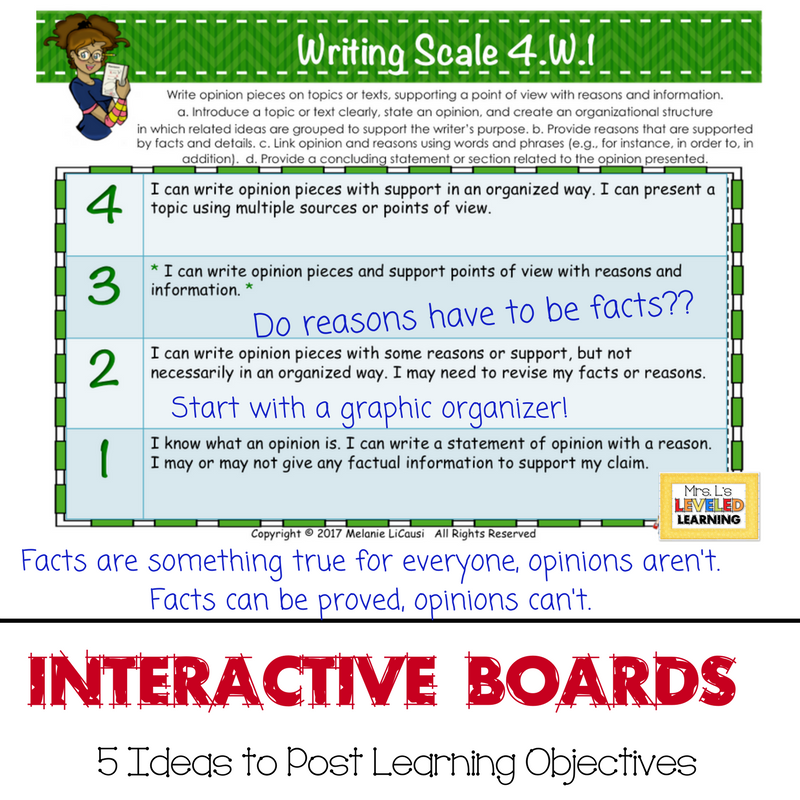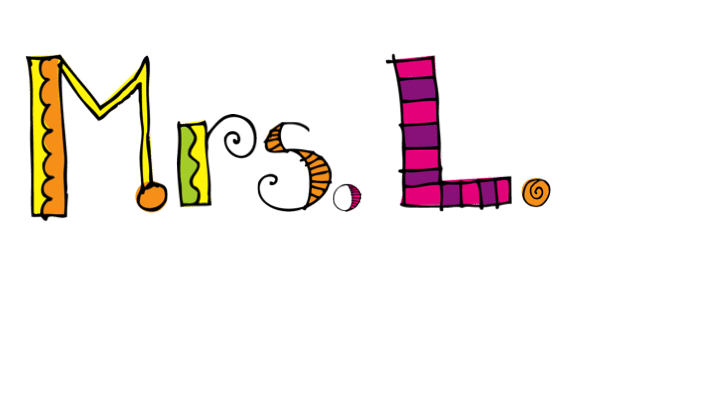1. Introduce Your Learning Objectives on an Interactive Whiteboard
I love to introduce my learning standards as a whole group. This gives me the chance to explain each statement and give examples. I ask my students what they know that connects to the learning goal. Sometimes I actually write examples, words, or student questions next to the learning objective to refer to later or guide my instructional planning. The introduction can be brief or in-depth, as long as the students see it in large print. This helps them pay attention visually. You can do this by projecting your learning scales posters onto a white board or opening the digital files on your SMARTboard. Writing them in large clear print on a white board or poster board can work as well.
2. Create a Bulletin Board for Each Subject
A bulletin board is a nice way to include many learning goals that overlap. Are you working on an English Language Arts project that includes many reading and writing objectives? Great! Post them all at once in one place. Allow your students to refer to them as needed. Keep them up as long as they apply, and rotate them out when you move on to new skills. (I find that 11 x 8.5 in. is convenient for printing.) The repetition of seeing, reading, and hearing the learning objectives will definitely improve their retention!
3. Post Your Student Learning Goals at Work Stations
Reinforce your learning goal by posting the relevant learning scale right in front of your students! I like to pin them to the wall so they float over the work station, making it easily accessible. It becomes a quick reference reminding students what to focus on. I only use scales at a work station after I have introduced each learning standard individually. I want to make sure that my students understand how the learning standard connects to their group task.
4. Design Desk Tags with Your Learning Standards
I took this idea from another teacher using Marzano learning goals and scales in her classroom. Brilliant! Some learning standards, like writing and grammar skills, are used every single day! These desk tags work as daily reminders to use appropriate punctuation, spelling, precise language and vocabulary, write in an organized way, and be willing to revise with peers or the teacher. There’s no way I could give all of these verbal reminders every time they write a paragraph. The VISUAL cue and accessibility of these desktop references mean that students have no excuse to forget. (The skills I just referred to are CCSS L.2, L.3, L.6, W.4, and W.5.) I like to group these ones, but you can print and paste any ones you want to; even rotate them for different study units.
5. Print Learning Scales for Student Binder or Folders
For goals that you work on all year, such as the ELA Speaking and Listening standards, you may want students to keep their own mini copies in a folder, binder, notebook or journal. Make sure they have access to this whenever they’re needed. Each individual standard would be introduced separately at the beginning of the year. Then the folder page works as a brief review or reminder. Sometimes I have students highlight ones they personally need to focus on, and star the ones they’ve mastered (to my satisfaction). I might also ask them to work on one or two for each discussion. The younger your students, the less content they should try to practice at any one time. This image shows the four ELA Speaking and Listening standards that I like to target during group discussions: CCSS SL.1 refers to appropriate participation norms, SL.3 refers to identifying a speaker’s evidence for claims, SL.4 refers to presenting my own claims well, and SL.6 refers to adapting speech to appropriate contexts or tasks.
Another idea for tracking student progress on skills, is to keep a Student Portfolio Binder. This can be really convenient, AND gives the students access to the learning goals, which is how they learn to take ownership! Read this blog post about how I use Student Portfolio Binders for Parent Conferences.
One of the most important things I have learned is to make things ROUTINE! There are so many things on your mind at any one moment. If scales don’t become a routine, you probably won’t do it consistently. If kids don’t have the opportunity to become proficient using a scale, then it’s not going to be an effective tool for them either.
Click on my Teacher Freebies tab to download the Student Portfolio pages for your grade level. Also try the Math & ELA Posters in your classroom. I’d love to hear any ideas you have for using scales or posting learning objectives in your room. Please leave a comment below!
Want even more detailed ideas? SIGN UP to “FOLLOW by EMAIL” in the side bar. You will receive a free copy of Mrs. L’s Guide to Marzano Scales: Making Research Practical. It’s like walking into my classroom. 😉

 Thank you to Shelly H. for her recent comments regarding …
Thank you to Shelly H. for her recent comments regarding …




